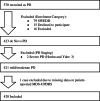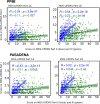Self-Report versus Clinician Examination in Early Parkinson's Disease
- PMID: 34897818
- PMCID: PMC9299700
- DOI: 10.1002/mds.28884
Self-Report versus Clinician Examination in Early Parkinson's Disease
Abstract
Background: Evaluating the discrepancies between patient-reported measures and clinician examination has implications for formulating individual treatment regimens.
Objective: This study investigated the association between health outcomes and level of self-reported motor-related function impairment relative to clinician-examined motor signs.
Methods: Recently diagnosed PD patients were evaluated using the Parkinson's Progression Marker Initiative (PPMI, N = 420) and the PASADENA phase II clinical trial (N = 316). We calculated the average normalized difference between each participant's part II and III MDS-UPDRS (Movement Disorder Society Unified Parkinson's Disease Rating Scale) scores. Individuals with score differences <25th or >75th percentiles were labeled as low- and high-self-reporters, respectively (those between ranges were labeled intermediate-self-reporters). We compared a wide range of clinical/biomarker readouts among these three groups, using Kruskal-Wallis nonparametric and Pearson's χ2 tests. Spearman's correlations were tested for associations between MDS-UPDRS subscales.
Results: In both cohorts, high-self-reporters reported the largest impairment/symptom experience for most motor and nonmotor patient-reported variables. By contrast, these high-self-reporters were similar to or less impaired on clinician-examined and biomarker measures. Patient-reported nonmotor symptoms on MDS-UPDRS part IB showed the strongest positive correlation with self-reported motor-related impairment (PPMI rs = 0.54, PASADENA rs = 0.52). This correlation was numerically stronger than the part II and clinician-examined MDS-UPDRS part III correlation (PPMI rs = 0.38, PASADENA rs = 0.28).
Conclusion: Self-reported motor-related impairments reflect not only motor signs/symptoms but also other self-reported nonmotor measures. This may indicate (1) a direct impact of nonmotor symptoms on motor-related functioning and/or (2) the existence of general response tendencies in how patients self-rate symptoms. Our findings suggest further investigation into the suitability of MDS-UPDRS II to assess motor-related impairments. © 2021 The Authors. Movement Disorders published by Wiley Periodicals LLC on behalf of International Parkinson and Movement Disorder Society.
Keywords: Movement Disorder Society Unified Parkinson's Disease Rating Scale; Parkinson's disease; motor signs; motor symptoms.
© 2021 The Authors. Movement Disorders published by Wiley Periodicals LLC on behalf of International Parkinson and Movement Disorder Society.
Figures


References
-
- Costa PT Jr, McCrae RR. Neuroticism, somatic complaints, and disease: is the bark worse than the bite? J Pers 1987;55(2):299–316. - PubMed
-
- Watson D, Pennebaker JW. Health complaints, stress, and distress: exploring the central role of negative affectivity. Psychol Rev 1989;96(2):234–254. - PubMed
-
- Howren MB, Suls J. The symptom perception hypothesis revised: depression and anxiety play different roles in concurrent and retrospective physical symptom reporting. J Pers Soc Psychol 2011;100(1):182–195. - PubMed
-
- Suls J, Howren MB. Understanding the physical‐symptom experience: the distinctive contributions of anxiety and depression. Curr Dir Psychol Sci 2012;21(2):129–134.
Publication types
MeSH terms
LinkOut - more resources
Full Text Sources
Medical
Research Materials
Miscellaneous

